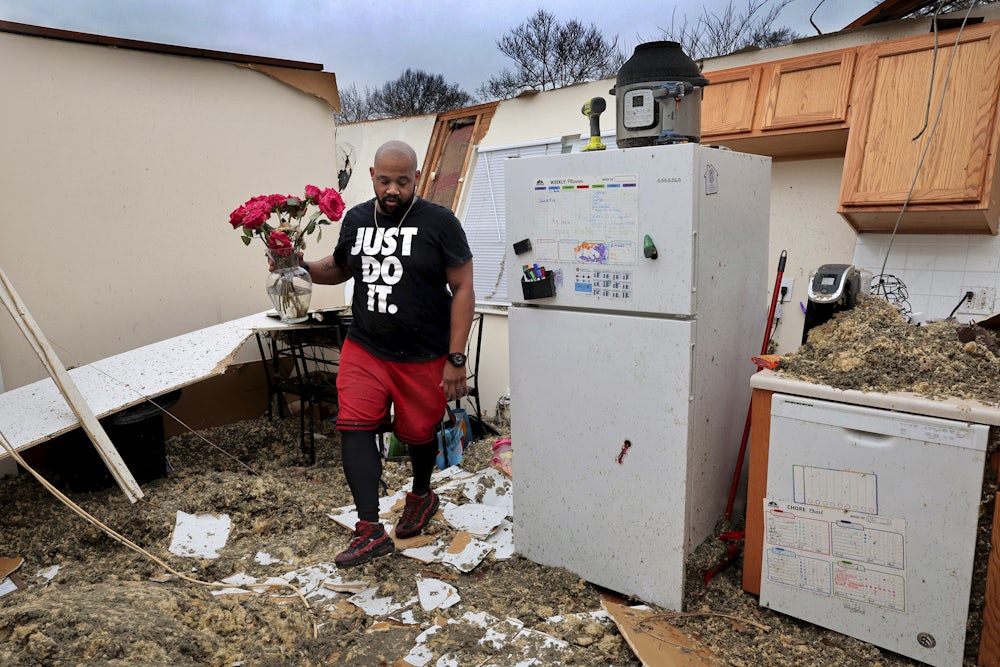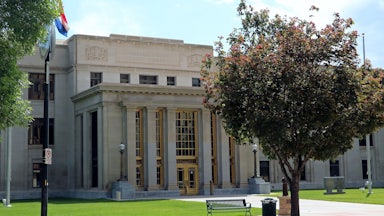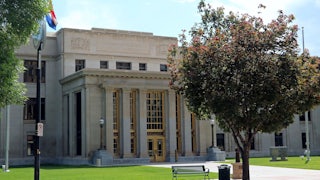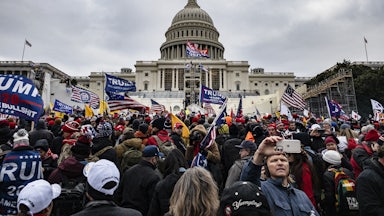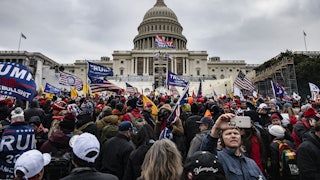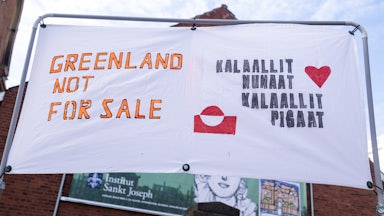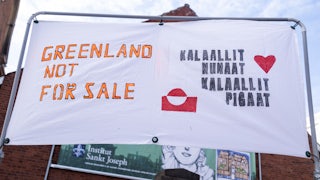On May 16, a mile-wide tornado with winds up to 152 miles per hour ripped through the city of St. Louis, its worst damage leaving parts of the city’s already disinvested northern neighborhoods in rubble. Missouri’s only statue of Martin Luther King Jr. was toppled. Century-old trees were uprooted. Homes were cracked down the mortar between bricks; roofs collapsed. Three people at the 121-year-old Centennial Christian Church were caught unaware when the tornado touched down and collapsed the north chapel.
As it happened, people throughout the city were caught by surprise because St. Louis’s 60 outdoor warning sirens were not triggered. St. Louis’s emergency management chief, Sarah Russell, was in a workshop at the time, and failed to provide clear instructions to the Fire Department to give the warning. It wouldn’t have mattered; upon later inspection, city officials learned the button to trigger the warning system was not working.
Meanwhile, inside Centennial Christian Church, DeMarco K. Davidson, Metropolitan Congregations United executive director, was trapped under rubble, using his body to try to protect 78-year-old church member Sherril Jackson. He knew Patricia Penelton, who had been volunteering with people experiencing homelessness in the neighborhood, had been trying to close the church door before the collapse. Davidson tried calling 911. The call infuriatingly went to an automated message telling him if he was experiencing an emergency, to call 911. He called a string of people he knew: his sister, a fraternity brother who is a police officer, a minister friend who in turn called a city alderwoman—who in turn called various first responders.
Eventually, Davidson and Jackson were rescued. Penelton, along with four other St. Louisians across the city, died. Dozens of people were injured. Thousands of buildings were damaged or destroyed, with an estimated $1.6 billion in damage across the city.
But in North St. Louis, an act of nature collided with city blocks that have been historically disinvested, redlined, and neglected. For weeks, people have stayed in tents at the front of their properties, bricks still strewn and fallen into the yard, waiting for help, unable to safely live in their homes, their loss made worse by poverty. Some who have spent the past many weeks distributing baby diapers, bottled water, and other basic necessities now worry that their neighborhoods have been left uniquely vulnerable to another, altogether unnatural sort of disaster: developers.
A drive through North St. Louis shows at least two kinds of damage. There are gorgeous, old brick buildings—some boarded up long ago. Payday loan shops are frequent. Some homes are toppled. In front of some, people guard fallen bricks, which can go for $270 a pallet, valuable material that belongs as much to the home as St. Louis’s history of well-built structures.
Some of it is irreplaceable, and not just the memories that get folded into a home. Many people in this neighborhood do not have or have lost their insurance.
In the days after the storm, NAACP St. Louis issued a report that tied historic redlining from the 1930s—which designated predominantly Black neighborhoods as “hazardous” investments—to modern insurance bias. Decades ago, color-coded maps labeled in red those neighborhoods that were deemed unsuitable for mortgages or insurance. Although this practice was outlawed by the 1968 Fair Housing Act, old-school redlining has been updated through other modern methods. A Missouri Department of Insurance study found race was the most predictive factor in determining a person’s insurance score today, and therefore their premium. Poor credit scores, which are also linked to race, can increase premiums by 78 percent.
According to the NAACP, insurance industry–funded aerial surveys of properties are used with computer models that can identify maintenance issues that lead to coverage denials. This practice, called “bluelining,” restricts insurance based on environmental factors that disproportionately affect historically disadvantaged communities. Building on what’s already baked in, the NAACP noted some insurance companies now use AI and machine learning algorithms based on historic data. In practice, that means that past instances in which insurance decisions were influenced by race or income are now influencing future decisions.
It’s far from theoretical. Researchers found that between 67 to 70 percent of households in North St. Louis were uninsured or underinsured. This is almost seven times the national average, though the six million homeowners who do not have adequate insurance nationally are disproportionately Black, Hispanic, and Native American.
Another complicating factor is how some of these homes were passed down through families. About one-third of storm-impacted homes in North St. Louis do not have a clear title due to something called “heirs’ property” status. This means when a family member dies without a will, the title remains in the name of the deceased. As the Urban Institute’s Housing Matters Initiative notes, fewer than a quarter of Black households have a will (compared to over half of white households), “a holdover from Reconstruction and Jim Crow, when many Black people could not access the legal system and were unable to draft legally binding wills.”
Family members can take the case to probate court, which costs money and usually results in assets being split across multiple heirs. But without a clear title, any heir can force all other owners to sell—which leaves the group vulnerable to developers if any single heir is willing to sell. Heirs’ property status can also disqualify homeowners from insurance policies.
It’s not uncommon for historically disadvantaged neighborhoods to suffer long after storms have receded. Neighborhoods that were damaged by Hurricane Katrina, for example, were 45.8 percent Black, more often renters (and so, less likely to have insurance), living below the poverty line or unemployed. Among survivors of Katrina who did have insurance, many were disappointed by what their insurance companies offered—but people in majority white neighborhoods were three times more likely to file complaints through the state, know they could do so in the first place, and therefore receive more funds.
In St. Louis, residents waited to apply for individual aid from the Federal Emergency Management Agency, or FEMA, funds that were delayed for weeks until President Donald Trump approved Missouri Governor Mike Kehoe’s request to declare major disasters in response to the tornado. Two thousand staffers short, FEMA announced in April that the agency would be ending door-to-door canvassing after disasters, a move that imperils those who are most vulnerable: the elderly, people with disabilities, those without transportation.
In the gap, local nonprofits and churches stepped in to help. At the end of June, a coalition of St. Louis groups organized a hub for help making insurance claims, as volunteer canvassers went out with free meals and supplies and to conduct an insurance claims survey.
When I visit St. John’s United Church of Christ in early July one Sunday morning, the sanctuary is packed, except for a few front rows saved for congregants. Everywhere else there are cases of bottled water and baby diapers, tents, tarps, tools, rakes, caulk, rope. It’s part distribution center, part volunteer hub.
Pastor Michelle Higgins has been on hand helping with recovery efforts. She says she doesn’t think she slept the night of May 16 and has worked 10 to 14 hours per day since (with a break for Juneteenth). For a long time, Action St. Louis was the only “organized operation” Higgins saw in her part of the city. She recalls early on that Mayor Cara Spencer advised, “Please do not self-deploy. A coordinated volunteer effort helps us make sure our first responders can do their jobs as effectively as possible.” Stuck in the midst of a disaster without enough help, Action St. Louis printed T-shirts that read “SELF-DETERMINED” and “SELF-DEPLOYED” on the back and kept up the work to help their neighbors.
At this point, though, people are tired, Higgins tells me. North St. Louis was already experiencing an unemployment crisis, a housing insecurity crisis, a fentanyl crisis. People in North St. Louis heard about the rapid response to restore Forest Park, an urban space larger than Central Park. With people in North St. Louis still living in their cars and suffering in the heat, she can’t help but wonder why help has been so slow to arrive.
“People call us a brick city, and a lot of developers want to move Black, poor people out of this area so they can buy it cheap and basically build another downtown, another Central West End, another business area,” she says, adding more pointedly, “If they starve our people up here, we’ll eat crumbs and they can displace us.”
Her view of the city’s response is tangled with mistrust of developers. Those suspicions are fueled, in part, by the recent mayoral campaign in which former Mayor Tishaura Jones, whom Higgins calls a “Northside baby,” was ousted by Spencer just weeks before the tornado. Spencer ran with financial backing from developer Bob Clark’s Clayco, which donated $111,330.25 to Spencer’s PAC—the amount he said his firm, Clayco, spent on a redevelopment bid rejected by the former Mayor Jones’s office. A construction company gave $10,000 to Spencer; real estate companies gave thousands; another Clayco subsidiary, Lamar Johnson Collaborative, gave $50,000 in March. Spencer (whose office did not respond to multiple requests for comment) out-fundraised and outspent Jones this spring. Jones, who defeated Spencer in 2021’s mayoral race, had campaigned on restoring underserved areas like North St. Louis; her coffers were not entirely free of architecture and builders’ dollars either.
Higgins says she has seen Jones out as part of the volunteer force serving the neighborhood.
“People are living in their cars. People are living in tents. They’re trying to protect their belongings as much as they can,” a frustrated Jones told me. “There’s no plan for any sort of temporary housing.” (Temporary shelters for tornado-impacted people closed July 11.) Jones has seen families filling plastic bins and trash bags and planning to stay at hotels until their money runs out. These are families leaving legacy homes, long paid-off places their grandparents bought “right when they escaped the Jim Crow South.”
Jones wonders why more than the $30 million promised by Spencer from a $280 million settlement St. Louis won in a lawsuit with NFL team the Rams can’t be used to simply buy out hotel space for those who need shelter or, at the very least, rent lockable PODs for residents who are spending their nights guarding the remains of their homes.
Thus far, Jones told me she is not aware of anyone receiving offers to purchase damaged North St. Louis homes, but neighbors are reporting new faces driving through, raising red flags.
Much as the NAACP, the Urban League, and Legal Services of Eastern Missouri are working to make sure people’s titles and deeds are in order for insurance purposes, Clayco has been discharged in what developer Bob Clark’s blog described as “one of the most collaborative public-private recovery responses our region has seen.” So-called “volunteer contractors” have been out cleaning up St. Louis storm damage, including Clayco executives Rick Moeckel and Katie Lane who St. Louis Business Journal reports have been “embedded” in Mayor Spencer’s office, working full-time since the tornado.
When I asked St. Louis NAACP president Adolphus M. Pruitt II about what some view as a city response that has neglected certain neighborhoods, he told me that the overall tornado recovery in St. Louis was conducted by faith-based and social services organizations—which makes sense.
“There’s no way in the world that I would expect any governmental agency to react that fast and respond in that way,” he said. Pruitt said he is “not interested in being critical of anybody or any organization that responded to this disaster.” He’s appreciative of every morsel of bread, every offer of help.
Pruitt is more focused on failures he perceives with the Missouri Department of Commerce and Insurance, which he says failed the residents of North St. Louis by not doing market studies long before the storm to reveal whether insurance companies have been redlining. Without regulation and oversight, too many residents now lack coverage in the midst of disaster—a situation the regulator could have helped avoid.
When asked, Pruitt indicated some of the leeriness of developers swooping in to buy up disaster-distressed properties, among some North St. Louis residents, is likely rooted in politics. To his mind, it was mainly the product of an especially bruising mayoral race. For now, St. Louis NAACP is monitoring to make sure there isn’t a “rash of homes being sold, developers sucking up property.” Last they checked, weeks ago, this wasn’t the case.
Moreover, he notes, many of the residents whose homes were damaged in North St. Louis were renters. He’s less concerned about one off-site property owner selling to another. But for those properties that were owner-occupied, “Their property’s been destroyed. That was their home. Now, some developer coming and taking advantage of them, their hardship,” taking away the wealth accumulated there, “yes, that I’m concerned about.”
Aly Rand has been very busy right in her neighborhood. She lives in Academy, which is just outside Central West End (a commercial district, which also houses Forest Park) but also is bordered by Delmar Boulevard. “The Delmar Divide” is shorthand for racial and economic segregation in St. Louis, with majority white residents to the south and majority Black to the north—investment to the south; disinvestment to the north. Rand describes her neighborhood as beautiful, historic. She saw city crews clearing her own private street for nine days.
She shares a public school district with her neighbors to the north of Delmar and describes what she’s seen as a “Katrina-level disaster.” People’s homes are not livable, some filling with mold. Others have tarps for roofs that will not hold through winter. She’s part of a group that came together after the storm and calls itself the Street Angels. One volunteer, Wesley Klaus, has been doing pro-bono mason work all over the neighborhood. Thus far the Street Angels have raised $50,000 in private donations alone, put toward dumpsters for trash removal, “and we are nowhere near done.”
I mentioned Pruitt’s perspective, that there are some direct service jobs people and mission-driven organizations are better equipped for than governments after a disaster, and Rand agrees—but she says, “When I say the city has not assisted us, it’s with basic civil services, so trees and debris, very dangerous and hazardous debris that has been sitting out on curbs for over nine weeks.” Trash pickup and environmental cleanup is municipal work, and it isn’t being done here.
Rand is careful to note that her neighbors north of Delmar are not in a neglected neighborhood. Their large homes are lovingly maintained. These families have insurance and have registered with FEMA. They are ticking off all the required boxes, despite the horror of the storm. One of these neighbors, for example, is a veteran and former firefighter who had his foot severed when a beam crashed through his house during the tornado.
The stay-at-home mom of five turned debris-removal expert says that there are years and “generations of racial abuse and neglect that the tornado took … and just made it visible for more people to see.” She feels naïve, as a white woman, talking about these issues. She’s exhausted; everyone is exhausted. Those who have been out working can’t quit now. In her case, “it would just be another white person walking away.”
Shortly after our interview, Jones let me know she received a call from a company called Doorstep, buying homes in her area, with a bonus for referrals to others interested in selling. When I called the number back, I got an AI messaging service for a company calling itself Home Nest (not Doorstep). Both companies’ LLCs are registered in Missouri, run by real estate agents located in and around St. Louis. The AI bot cheerfully told me, “We help homeowners get a fair cash offer for their homes.”
